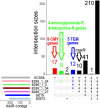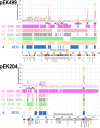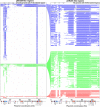Plasmids shape the diverse accessory resistomes of Escherichia coli ST131
- PMID: 33997610
- PMCID: PMC8115979
- DOI: 10.1099/acmi.0.000179
Plasmids shape the diverse accessory resistomes of Escherichia coli ST131
Abstract
The human gut microbiome includes beneficial, commensal and pathogenic bacteria that possess antimicrobial resistance (AMR) genes and exchange these predominantly through conjugative plasmids. Escherichia coli is a significant component of the gastrointestinal microbiome and is typically non-pathogenic in this niche. In contrast, extra-intestinal pathogenic E. coli (ExPEC) including ST131 may occupy other environments like the urinary tract or bloodstream where they express genes enabling AMR and host cell adhesion like type 1 fimbriae. The extent to which commensal E. coli and uropathogenic ExPEC ST131 share AMR genes remains understudied at a genomic level, and we examined this here using a preterm infant resistome. We found that individual ST131 had small differences in AMR gene content relative to a larger shared resistome. Comparisons with a range of plasmids common in ST131 showed that AMR gene composition was driven by conjugation, recombination and mobile genetic elements. Plasmid pEK499 had extended regions in most ST131 Clade C isolates, and it had evidence of a co-evolutionary signal based on protein-level interactions with chromosomal gene products, as did pEK204 that had a type IV fimbrial pil operon. ST131 possessed extensive diversity of selective type 1, type IV, P and F17-like fimbriae genes that was highest in subclade C2. The structure and composition of AMR genes, plasmids and fimbriae vary widely in ST131 Clade C and this may mediate pathogenicity and infection outcomes.
Keywords: Escherichia coli; Genome; ST131; evolution; fimbrial; infection; plasmid.
© 2021 The Authors.
Conflict of interest statement
The authors declare that there are no conflicts of interest.
Figures



Similar articles
-
Strain belonging to an emerging, virulent sublineage of ST131 Escherichia coli isolated in fresh spinach, suggesting that ST131 may be transmissible through agricultural products.Front Cell Infect Microbiol. 2023 Oct 9;13:1237725. doi: 10.3389/fcimb.2023.1237725. eCollection 2023. Front Cell Infect Microbiol. 2023. PMID: 37876872 Free PMC article.
-
Escherichia coli ST131: a multidrug-resistant clone primed for global domination.F1000Res. 2017 Feb 28;6:F1000 Faculty Rev-195. doi: 10.12688/f1000research.10609.1. eCollection 2017. F1000Res. 2017. PMID: 28344773 Free PMC article. Review.
-
The ST131 Escherichia coli H22 subclone from human intestinal microbiota: Comparison of genomic and phenotypic traits with those of the globally successful H30 subclone.BMC Microbiol. 2017 Mar 27;17(1):71. doi: 10.1186/s12866-017-0984-8. BMC Microbiol. 2017. PMID: 28347271 Free PMC article.
-
Escherichia coli ST131-H22 as a Foodborne Uropathogen.mBio. 2018 Aug 28;9(4):e00470-18. doi: 10.1128/mBio.00470-18. mBio. 2018. PMID: 30154256 Free PMC article.
-
The Significance of Epidemic Plasmids in the Success of Multidrug-Resistant Drug Pandemic Extraintestinal Pathogenic Escherichia coli.Infect Dis Ther. 2023 Apr;12(4):1029-1041. doi: 10.1007/s40121-023-00791-4. Epub 2023 Mar 22. Infect Dis Ther. 2023. PMID: 36947392 Free PMC article. Review.
Cited by
-
Convergence of virulence and antimicrobial resistance in increasingly prevalent Escherichia coli ST131 papGII+ sublineages.Commun Biol. 2022 Jul 28;5(1):752. doi: 10.1038/s42003-022-03660-x. Commun Biol. 2022. PMID: 35902767 Free PMC article.
-
A primer on correlation-based dimension reduction methods for multi-omics analysis.J R Soc Interface. 2023 Oct;20(207):20230344. doi: 10.1098/rsif.2023.0344. Epub 2023 Oct 11. J R Soc Interface. 2023. PMID: 37817584 Free PMC article. Review.
-
Bacterial plasmid-associated and chromosomal proteins have fundamentally different properties in protein interaction networks.Sci Rep. 2022 Nov 10;12(1):19203. doi: 10.1038/s41598-022-20809-0. Sci Rep. 2022. PMID: 36357451 Free PMC article.
-
Dissemination of carbapenemase-producing Enterobacterales in Ireland from 2012 to 2017: a retrospective genomic surveillance study.Microb Genom. 2023 Mar;9(3):mgen000924. doi: 10.1099/mgen.0.000924. Microb Genom. 2023. PMID: 36916881 Free PMC article.
-
Strain belonging to an emerging, virulent sublineage of ST131 Escherichia coli isolated in fresh spinach, suggesting that ST131 may be transmissible through agricultural products.Front Cell Infect Microbiol. 2023 Oct 9;13:1237725. doi: 10.3389/fcimb.2023.1237725. eCollection 2023. Front Cell Infect Microbiol. 2023. PMID: 37876872 Free PMC article.
References
LinkOut - more resources
Full Text Sources
Other Literature Sources
Miscellaneous
